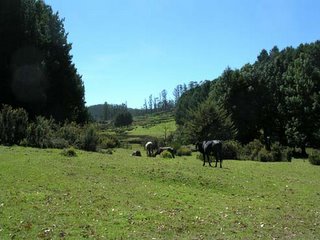Raj Remains
“My mum may be the last,” Mike says. He is a short, compact man with a deeply tanned complexion, blue eyes, unruly sandy hair, and a headband, is dressed in khakis and sporting a small backpack. At first glance, I figure he’s in his early thirties but outfitted to pass as one of the many young, 20-something Western visitors who seem to frequent India’s byways. A second look takes in a thickened waist, thinning hair, and fine lines around the eyes. The wrong end of the 50’s, I think.
Mike is talking about the last of the British colonials, musing over who departed after Indian independence – almost everyone. “Colonel P had Greening Way, a big house at Talaganandu,” he says. “His son, William, who married Mary Smith-Rankin, raised his family there, but now they’re all gone. And … ,” he talks on, naming the dead and the disappeared as though they are mutual friends and we’re along to catch up on local gossip. Tallying up some ten minutes and two kilometers of walking later, he decides his mother, now in her 90’s, is it. She’s the last of the British Raj, at least in this part of India.
He doesn’t count himself. “We came to India in the 60’s,” he says. “And I went to school here.” His father was Indian and, despite his British Raj look and his public school accent, India is “ours” and he is an Indian.
We trek up and down hills covered with gorse and pine, with eucalyptus and lantana. Moss and Kikuyu grass cover the ground with a nappy green that gives way to rock outcroppings spotted by lichen. Small streams rush through the valley bottoms, and we catch glimpses of the thatched roofs of huts.
“When we got here,” he says, the pronoun choice glaring, “these hills were bare. We brought the cattle you see now. We planted the trees, the tea bushes, and most of the flowering shrubs. The pines are trash, of course. A good wind blows them down, but they grow fast. And, the gorse … . A lot of plants caught a free ride here, were accidents.”
The gorse was a nuisance, too. Huge thickets of it, thorny plants growing as tall as small trees, made forward movement difficult in places and possible only because wild boar and cattle had been here before us, constructed intricate networks of paths we could stoop and edge along.
“You have to keep an eye out,” Mike tells us. “There’s a tiger in these parts who took four people last year. They say they got him.” But, clearly he doesn’t believe it. “You’re safe,” he says, “as long as you move in a group and let tiger know you’re not alone.”
As an afterthought, he adds, “The same is true of snakes.”
With Mike’s steady patter, we have no fear of tigers or snakes.
We listen and learn how Ooty, a town of the Nilgiri Hills in southern India and situated at 8,000 feet above sea level, was a picturesque village until after independence. “During the Raj, people came here to get away from the heat of the lowlands.” By Raj, he meant the period of British occupation. “Then,” he went on, “the Tamils moved in bringing their block-building, flat-roofed architecture with them.
My calf muscles are stinging, my lungs think hill climbing at 8,000 feet is well outside their job description, and I’m lagging behind … looking to any lurking tiger like an easy meal. The thought is stirring, and I hurry to catch up.
“Trekking,” Mike is saying as I close the gap, “is becoming popular. Everyone wants to trek, although what they mean is usually closer to a stroll through the country. But you find some who want to see the elephant in the wild. That’s where you have to go to the jungle.”
Right now, the idea of jungle and trekking is losing its appeal, and I’m feeling rather like Mike’s ninety-plus year old “mum” … like I’ve been dropped into a situation out of my own time and place. It’s great to visit and taste the differences, but … . My footsteps slow.
I’m lagging again; falling behind. Even thoughts of tiger and snakes are insufficient to move my legs faster. Then, I imagine Mike’s mum left behind by all of her contemporaries, and I pick up the pace.


